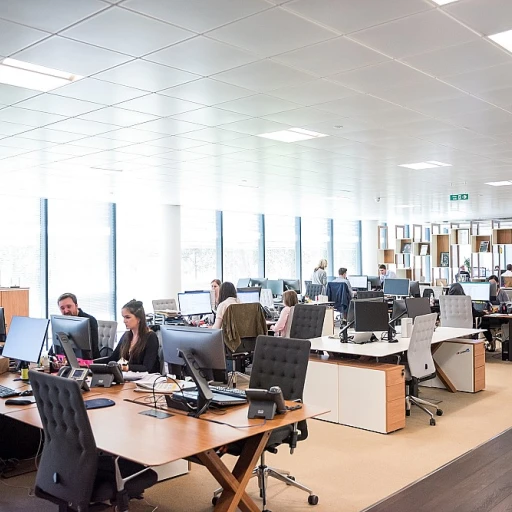Understanding Change Management
Getting to Grips with Change Management
Change management is the art of guiding people, teams, and organizations through transitions. It's about helping employees adapt, ensuring that the shift is as smooth as possible. Imagine a company rolling out a new software system. Without a structured change management approach, employees might feel lost or resistant, leading to delays and frustration. But with effective strategies, the transition can be seamless, fostering a positive atmosphere and boosting productivity.
At its core, change management is about people. It involves understanding how individuals react to change, what support they need, and how to communicate effectively. This human-centric approach is essential for any organization aiming to implement change successfully. Whether it's adopting new technology, restructuring teams, or altering business processes, the focus is always on the people who make it happen.
Organizations that excel in change management often see higher employee engagement and satisfaction. They know that effective change isn't just about new tools or processes—it's about nurturing a culture that embraces change. This involves ongoing learning and development, empowering employees with the skills and knowledge they need to thrive in a changing environment.
For those interested in enhancing their change management skills, exploring resources like enhancing change management skills for successful organizational transformation can provide valuable insights and practical tips.
In the upcoming sections, we'll explore how training plays a pivotal role in successful change management, and how to design and measure effective training programs. Stay tuned to discover how training can turn potential resistance into enthusiastic participation.
The Importance of Training in Change Management
Why Focusing on Training Matters
Think of training as the glue that holds a change initiative together. It's what takes lofty goals and turns them into real-world successes. Without training, your employees might feel like they're being thrown into the deep end of the pool with no knowledge of how to swim. In today's fast-paced business environment, keeping everybody's skills sharp and relevant is key to not just surviving change, but thriving through it. Effective learning empowers people to not only execute their roles better but also contribute to the company's broader goals. It's the organization saying, "Hey, we believe in you," which can boost morale and motivation across the board. Employees equipped with the right skills through proper training can become change leaders in their own right, offering insights and solutions that drive the change process forward. By focusing on training, you build a solid foundation for any organizational change. It ensures that everyone on the team is on the same page, which reduces friction and resistance to change. Change management is all about bringing people along for the ride, and there's no better way to do that than through comprehensive training programs.The Domino Effect of Comprehensive Training
Proper training isn’t just something you checkbox and then move on. It’s about creating a ripple effect where each employee takes what they learn to enhance not just their personal skills, but also the organization as a whole. Think about that time you learned something new and couldn't wait to share it. The same applies to your team members; once they start seeing the positive impact of their learning, they will naturally pass it along. Training programs designed well can usher in a new era of innovation within an organization. Employees gain new perspectives, tools, and techniques that can be used to tackle challenges and spark creativity. Each training session becomes an opportunity for development, both individually and organizationally. Further reading on crafting effective change initiatives can be found in our practical guide to management training: Mastering Change: A Practical Guide to Management Training. This resource provides more insights into management training techniques that can help your change become truly successful.Designing Effective Training Programs
Crafting a Training Blueprint
Creating a successful training program is like building a house; you need a solid foundation and a clear blueprint. In change management, this foundation is understanding the needs of your organization and its people. Every organization is unique, and so are its employees. Tailoring training to match the specific needs of your team is crucial for success.
Involving Leadership and Teams
Leadership plays a pivotal role in shaping the training program. When leaders are actively involved, it sets a positive tone for the rest of the organization. Engaging team members in the planning phase helps to address potential resistance change. By involving them early, you can incorporate their feedback, making the training more relevant and effective.
Setting Clear Objectives
Clear objectives are the backbone of any training program. They guide the content and help measure success. Objectives should focus on the skills and knowledge employees need to support the change initiatives. Whether it's improving communication, enhancing technical skills, or fostering leadership, having clear goals ensures everyone is on the same page.
Choosing the Right Tools and Techniques
In today's fast-paced world, the choice of training tools and techniques can make or break a program. From online modules to interactive workshops, the options are endless. The key is to select methods that align with your objectives and resonate with your employees. Blended learning, which combines various formats, often provides the flexibility and engagement needed for effective change training.
Continuous Development and Feedback
Training doesn't end after a few sessions. Continuous development is essential for long-term success. Regular feedback from participants can help refine the program and address any gaps. Encouraging a culture of learning within the organization ensures that employees are always ready to adapt to new challenges.
For more insights on how to enhance your change management skills, check out this comprehensive guide.
Training Methods and Techniques
Exploring Different Training Approaches
Training methods are like tools in a toolbox, each serving a purpose in helping employees adapt to change. Let's break down some popular techniques and see how they can boost the learning experience.Interactive Workshops
Workshops are a great way to engage employees in hands-on learning. They provide a space for team members to practice new skills and knowledge in a supportive environment. Workshops encourage participation, making the change process feel more collaborative and less like a top-down directive. Employees often leave these sessions feeling more connected to the change initiatives.Online Learning Platforms
In today's fast-paced world, online learning platforms offer flexibility and convenience. They allow employees to learn at their own pace, fitting training into their busy schedules. These platforms often include interactive elements like quizzes and videos, which can help reinforce learning and make it more engaging. Organizations can track progress and ensure that team members are on the right path.Mentorship and Coaching
Personalized mentorship and coaching can be incredibly effective in change management. Experienced leaders can share their insights and guide employees through the challenges of change. This one-on-one interaction helps build trust and provides employees with a support system. It also fosters a culture of continuous learning and development within the organization.Role-Playing and Simulations
Role-playing and simulations put employees in real-life scenarios, allowing them to practice their responses to change in a safe setting. This method can help people develop problem-solving skills and boost their confidence in handling new situations. It's a dynamic way to prepare teams for the unexpected twists and turns of change initiatives.Feedback and Reflection Sessions
Regular feedback and reflection sessions are crucial for effective training. They provide opportunities for employees to share their experiences, express concerns, and suggest improvements. These sessions foster open communication and help organizations fine-tune their training programs to better meet the needs of their people. By using a mix of these methods, organizations can create a comprehensive training program that addresses different learning styles and preferences. This diversity in training approaches not only enhances the effectiveness of the change management process but also empowers employees to embrace change with confidence.Measuring Training Effectiveness
Training is only as good as its ability to be measured. It's essential to ensure that the time and effort spent in developing skills, knowledge, and new ways of thinking are reflected in real-world outcomes. As organizations go about this change management process, it's important to look at existing training programs to see if they provide the intended benefits. However, measuring training effectiveness can often feel like searching for a needle in a haystack.
Quantifying Success in Learning
One of the first steps in measuring the usefulness of a training program is to set clear goals. This helps you identify exactly what you want by creating benchmarks to see how far you've come. These can be as straightforward as improved job performance or learning new skills. Once these goals are etched in stone, you can compare results before and after the training. Use objective tools such as quizzes, surveys, and performance reviews to collect data on employees' progress. This helps in highlighting any enhancements in knowledge or skills.
Feedback is Gold
Don't underestimate the power of listening to those on the receiving end of a training initiative. Gathering feedback from participants can shed light on the program's strengths and weaknesses. Did the sessions hit home? Were they engaging and relevant? As people digest this feedback, it helps in making adjustments to improve the training mechanism further.
A Culture of Development
Besides raw numbers, the nurturing of a continuous learning culture speaks volumes. Witness how team members start applying what they learn in innovative ways around the organization. This change in behavior can be a sign of a successful training program that goes beyond numbers and proves its weight in gold.
Evaluating Change Process
A key aspect is aligning your training needs with the overall change objectives. Identify if the training is helping to move the needle towards the desired change. If not, it might be time to tweak the approach. Keep an eye on how well leadership is taking charge and how employees are adapting to new changes that the training addresses.
Training becomes a true ally in successful change when it is meticulously assessed and continually refined. The goal is not just to launch a program but to witness its positive effects echo across the company's corridors.
Overcoming Training Challenges
So, let's chat about the real-world hurdles we face when setting up effective training for change. It's not just about having the right tools or a snazzy training program; it's about tackling the things that trip us up—those pesky challenges that can turn even the best-laid plans on their head.
Addressing Resistance and Hesitance
One biggie in any change initiative is resistance. It's human nature, right? Sometimes employees just don't want to shift from the familiar. Whether it's the fear of the unknown or simply a preference for the status quo, people can be hesitant to jump on board. To help folks overcome this, build a culture that champions open communication and empathy. Leadership plays a critical role here, demonstrating the values of the change through action and not just words.
Customizing for Diverse Learning Styles
The one-size-fits-all approach rarely cuts it. Each team member brings unique skills and ways of learning. Some might love a hands-on experience, while others might prefer weaving knowledge through interactive sessions. Incorporating diverse teaching methods tailored to different learning styles can make your training sessions pop and keep folks engaged. Adjusting your training program to the needs of your people makes it not just more inclusive, but way more effective.
Managing Time and Resources
Time is money—or so the saying goes—and it's true that effective training requires a bit of both. Juggling the day-to-day tasks with training sessions can stress resources to the max. Leaders must find that sweet spot where ongoing operations and development don't clash. Prioritize what’s key to both the organization’s objectives and employees’ personal growth. A little strategic planning goes a long way in easing the burden.
Fostering Continuous Development
We can't afford to see training as a one-off gig. Development should be ongoing, feeding back into the organization's growth and innovation. Encourage a culture where learning is ongoing, and mistakes are seen as part of the learning curve, not setbacks. By continually focusing on development, an organization becomes more adaptable to change, ready to pivot when needed while maintaining a robust foundation of skills and knowledge.
Overcoming training challenges is a quintessential part of successful change management. It's about setting up an environment where employees feel supported and are equipped with the skills they need to adapt and thrive amid changes. So the journey isn't just about change, but about how we bring people along for the ride.






